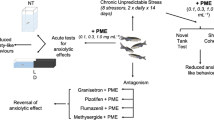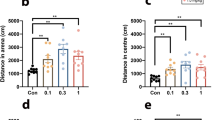Abstract
There is scarce information regarding the effects of anesthetic doses of the non-competitive N-methyl-d-aspartate receptor antagonist ketamine on anxiety. The current study evaluated the acute effects of intraperitoneally (i.p.) administered anesthetic ketamine (100 mg/kg) i.p. on anxiety in rats. For this purpose, the light/dark and the open field tests were utilized. The effects of anesthetic ketamine on motility were also examined using a motility cage. In the light/dark test, anesthetic ketamine, administered 24 h before testing reduced the number of transitions between the light and dark compartments and the time spent in the light compartment in the rats compared with their control cohorts. In addition, ketamine was found to exert a depressive effect on rats’ motility. In the open field test, animals treated with anesthetic ketamine 24 h before testing spent essentially no time in the central area of the apparatus, decreased horizontal ambulatory activity, and preserved to a certain extent their exploratory behaviour compared to their control counterparts. The results suggest that, in spite of its hypokinetic effect, a single anesthetic ketamine administration apparently induces an anxiety-like state, while largely preserving exploratory behaviour in the rat. These effects were time-dependent they since they were extinguished when testing was carried out 48 h after anesthetic ketamine administration.




Similar content being viewed by others
References
Javitt DC, Zukin RS (1991) Recent advances in the phencyclidine model of schizophrenia. Am J Psychiatry 148:1301–1308
Krystal JH, Karper LP, Seibyl JP, Freeman GK, Delaney R, Bremner JD, Heninger GR, Bowers MB, Charney DS (1994) Subanesthetic effects of the noncompetitive NMDA antagonist ketamine, in humans. Psychotomimetic, perceptual, cognitive and neuroendocrine responses. Archiv Gen Psychiatry 51:199–214
Yamakura T, Chavez-Noriega LE, Harris RA (2009) Subunit-dependent inhibition of human neuronal nicotinic acetylcholine receptors and other ligand-gated ion channels by dissociative anesthetics ketamine and dizocilpine. Anesthesiology 92:1144–1153
Corssen G, Domino EF (1966) Dissociative anesthesia: further pharmacologic studies and first clinical experience with the phencyclidine derivative CI-581. Anesth Analg 45:29–40
Okon T (2007) Ketamine: an introduction for the pain and palliative medicine physician. Pain Phys 10:493–500
Akillioglou K, Babar Melik E, Melik E, Boga A (2012) Effects of ketamine on exploratory behaviour in BALB/C and C57BL/6 mice. Pharmacol Biochem Behav 100:513–517
Babar E, Ozgunen T, Melik E, Polat S, Akman H (2001) Effects of ketamine on different types of anxiety/fear and related memory in rats with lesions of the median raphe nucleus. Eur J Pharmacol 431:315–320
Engin E, Treit D, Dickson CT (2009) Anxiolytic- and antidepressant-like properties of ketamine in behavioural and electrophysiological animal models. Neuroscience 161:359–369
de Sousa FC, do Carmo de Oliveira Cito M, da Silva MI, Moura BA, de Aquino Neto MR, Feitosa ML, de Castro Chavez R, Macedo DS, de Vasconcelos SM, de Franca Fonteles MM, de Sousa FC (2010) Behavioraal alterations and pro-oxidant effect of a single ketamine administration in mice. Brain Res Bul 83:9–15
Silvestre JS, Nadal R, Pallares M, Ferre N (1997) Acute effects of ketamine in a holeboard, the elevated plus-maze, and the social interaction test in Wistar rats. Depress Anxiety 5:29–33
Becker A, Peters B, Schroeder H, Mann T, Huether G, Grecksch G (2003) Ketamine-induced changes in rat behaviour: a possible animal model of schizophrenia. Prog Neuropsychopharmacol Biol Psychiatry 27:687–700
Trevlopoulou A, Touzlatzi N, Pitsikas N (2016) The nitric oxide donor sodium nitroprusside attenuates recognition memory deficits and social withdrawal produced by the NMDA receptor antagonist ketamine and induces anxiolytic-like behaviour in rats. Psychopharmacology 233:1045–1054
Magalhaes A, Valentim A, Venancio C, Pereira M, Melo P, Summavielle T, Antunes L (2017) Ketamine alone or combined with midazolam or dexmedetomidine does not affect anxiety-like behaviours and memory in adult Wistar rats. Lab Anim 51:147–159
Crawley JN, Goodwin FK (1980) Preliminary report of a simple animal behaviour for the anxiolytic effect of benzodiazepines. Pharmacol Biochem Behav 13:167–170
Prut L, Belzung C (2003) The open field as a paradigm to measure the effects of drugs on anxiety-like behaviours: a review. Eur J Pharmacol 463:3–33
Crawley JN (1985) Exploratory behavior models of anxiety in mice. Neurosci Biobehav Rev 9:37–44
Grivas V, Markou A, Pitsikas N (2013) The metabotropic glutamate 2/3 receptor agonist LY379268 induces anxiety-like behavior at the highest dose tested in two rat models of anxiety. Eur J Pharmacol 715:105–110
Antoniou K, Papathanasiou G, Panagis G, Nomikos GG, Hyphantis T, Papadopoulou-Daifoti Z (2004) Individual responses to novelty predict qualitative differences in d-amphetamine-induced open field but not reward-related behaviors in rats. Neuroscience 23:613–623
Delis F, Polissidis A, Poulia N, Justinova Z, Nomikos GG, Goldberg SR, Antoniou K (2017) Attenuation of cocaine-induced conditioned place preference and motor activity via cannabinoid CB2 receptor agonism and CB1 receptor antagonism in rats. Int J Neuropsychopharmacol 20:269–278
Polissidis A, Galanopoulos A, Naxakis G, Papahatjis D, Papadopoulou-Daifoti Z, Antoniou K (2013) The cannabinoid CB1 receptor biphasically modulates motor activity and regulates dopamine and glutamate release region dependently. Int J Neuropsychopharmacol 6:1–11
Thiel CM, Muller CP, Huston JP, Schwarting RK (1999) High versus low reactivity to a novel environment: behavioural, pharmacological and neurochemical assessments. Neuroscience 93:243–251
Pitsikas N, Boultadakis A (2009) Pre-training administration of anesthetic ketamine differentially affects rats’ spatial and non-spatial recognition memory. Neuropharmacology 57:1–7
Kirk RE. (1968) Experimental design: procedures for the behavioral science. Brooks/Cole, Belmont, CA
Bourin M, Hascoet M (2003) The mouse light/dark box test. Eur J Pharmacol 463:55–65
Belzung C, Misslin R, Vogel E, Dodd RH, Chapouthier G (1987) Anxiogenic effects of methyl-β-carboline-carboxylate in a light/dark choice situation. Pharmacol Biochem Behav 28:29–33
Hetzler BE, Wautlet BS (1986) Ketamine-induced locomotion in rats in an open field. Pharmacol Biochem Behav 22:653–655
Mihara T, Kikuchi T, Kamiya Y, Koga M, Uchimoto K, Kurahashi K, Goto T (2012) Day or night administration of ketamine and pentobarbital differentially affect circadian rhythms of pineal melatonin secretion and locomotor activity in rats. Anesth Analg 115:805–813
Ribeiro PO, Rodrigues PC, Valentim AM, Antunes LM (2013) A single intraperitoneal injection of ketamine does not affect spatial working, reference memory or neurodegeneration in adult mice. Eur J Anesthesiol 30:618–626
Irifune M, Shimizu T, Nomoto M (1992) Ketamine-induced anesthesia involves the N-methyl-d-aspartate receptor-channel complex in mice. Brain Res 596:1–9
Irifune M, Sato T, Kamata Y, Nishikawa T, Dohi T, Kawahara M (2000) Evidence for GABA(A) receptor agonistic properties of ketamine: convulsive and anesthetic behavioral models in mice. Anesth Analg 91:230–236
Hovatta I, Tennart RS, Helton R, Marr RA, Singer O, Redwine JM, Ellison JA, Schad EE, Verma IM, Lockhart DJ, Barlow C (2005) Glyoxalase 1 and glutathione reductase 1 regulate anxiety in mice. Nature 438:662–666
Moller C, Bing O, Heilig M (1994) c-fos expression in the amygdala: in vivo antisense modulation and role in anxiety. Cell Mol Neurobiol 14:415–423
Venancio C, Felix L, Almeida V, Coutinho J, Antunes L, Peixoto F, Summavielle T (2015) Acute ketamine impairs mitochondrial function and promotes superoxide dismutase activity in the rat brain. Anesth Analg 120:320–328
Nakao S, Nagata A, Miyamoto E, Masugawa M, Murayama T, Shingu K (2003) Inhibitory effect of profolol on ketamine-induced c-Fos expression in the rat posterior cingulate and retrospenial cortices is mediated by GABAA receptor activation. Acta Anesthesiol Scand 47:284–290
Bouwknecht JA, Paylor R (2008) Pitfalls in the interpretation of genetic and pharmacological effects of anxiety-like behaviour in rodents. Behav Pharmacol 19:385–402
Ressler KJ, Mayberg HS (2007) Targeting abnormal brain circuits in mood and anxiety disorders: from the laboratory to the clinic. Nat Neurosci 10:116–1124
Author information
Authors and Affiliations
Corresponding author
Ethics declarations
Conflict of interest
The authors declare no potential conflicts of interest with respect to authorship and/or publication of this article.
Research Involving Animal Rights
All applicable international and national guidelines for the care and use of animals were followed.
Additional information
Publisher’s Note
Springer Nature remains neutral with regard to jurisdictional claims in published maps and institutional affiliations.
Rights and permissions
About this article
Cite this article
Pitsikas, N., Georgiadou, G., Delis, F. et al. Effects of Anesthetic Ketamine on Anxiety-Like Behaviour in Rats. Neurochem Res 44, 829–838 (2019). https://doi.org/10.1007/s11064-018-02715-y
Received:
Accepted:
Published:
Issue Date:
DOI: https://doi.org/10.1007/s11064-018-02715-y




